Judea
Judea or Judaea (/dʒuːˈdiːə/ or /dʒuːˈdeɪə/;[1] from Hebrew: יהודה, Standard Yəhūda, Tiberian Yehūḏā; Greek: Ἰουδαία, Ioudaía; Latin: Iūdaea) is an ancient, historic, Biblical Hebrew, contemporaneous Latin, and the modern-day name of the mountainous southern part of the region of Israel and part of the West Bank.
Judea
יְהוּדָה | |
|---|---|
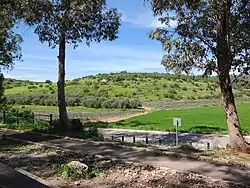 A hill in Judea | |
| Coordinates: 31°40′N 35°00′E | |
| Part of | Israel and the West Bank |
| Highest elevation (Mount Hebron) | 1,020 m (3,350 ft) |
The name originates from the Hebrew name Yehudah, a son of the biblical patriarch Jacob/Israel, with Yehudah's progeny forming the biblical Israelite tribe of Judah (Yehudah) and later the associated Kingdom of Judah.
Related nomenclature continued to be used by the Babylonians, Persian, Hellenistic, and Roman periods as the Babylonian and Persian Yehud, Hasmonean Kingdom of Judea, and consequently Herodian and Roman Judea, respectively.[2] Under Hasmonean, Herodian and Roman rule, the term was applied to an area larger than the historical region of Judea, which at times included regions such as Samaria, Galilee, Perea and others. At around the time of the Bar Kokhba revolt, in 135 CE, the province of Judaea was renamed Syria Palaestina.[2]
The term Judea was revived by the Israeli government in the 20th century as part of the Israeli administrative district name Judea and Samaria Area for the territory generally referred to as the West Bank.[3]
Etymology
The name Judea is a Greek and Roman adaptation of the name "Judah", which originally encompassed the territory of the Israelite tribe of that name and later of the ancient Kingdom of Judah. Nimrud Tablet K.3751, dated c. 733 BCE, is the earliest known record of the name Judah (written in Assyrian cuneiform as Yaudaya or KUR.ia-ú-da-a-a).
Judea was sometimes used as the name for the entire region, including parts beyond the river Jordan.[4] In 200 CE Sextus Julius Africanus, cited by Eusebius (Church History 1.7.14), described "Nazara" (Nazareth) as a village in Judea.[5] The King James Version of the Bible refers to the region as "Jewry".[6]
"Judea" was a name used by English speakers for the hilly internal part of Mandatory Palestine until the Jordanian rule of the area in 1948. For example, the borders of the two states to be established according to the UN's 1947 partition scheme[7] were officially described using the terms "Judea" and "Samaria" and in its reports to the League of Nations Mandatory Committee, as in 1937, the geographical terms employed were "Samaria and Judea".[8] Jordan called the area ad-difa’a al-gharbiya (translated into English as the "West Bank").[9] "Yehuda" is the Hebrew term used for the area in modern Israel since the region was captured and occupied by Israel in 1967.[10]
Historical boundaries
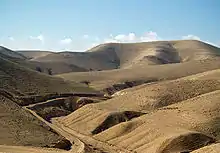
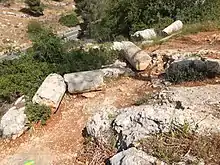
Roman-period definition
The first century Roman-Jewish historian Josephus wrote (The Jewish War 3.3.5):
In the limits of Samaria and Judea lies the village Anuath, which is also named Borceos.[11] This is the northern boundary of Judea. The southern parts of Judea, if they be measured lengthways, are bounded by a village adjoining to the confines of Arabia; the Jews that dwell there call it Jordan. However, its breadth is extended from the river Jordan to Joppa. The city Jerusalem is situated in the very middle; on which account some have, with sagacity enough, called that city the Navel of the country. Nor indeed is Judea destitute of such delights as come from the sea, since its maritime places extend as far as Ptolemais: it was parted into eleven portions, of which the royal city Jerusalem was the supreme, and presided over all the neighboring country, as the head does over the body. As to the other cities that were inferior to it, they presided over their several toparchies; Gophna was the second of those cities, and next to that Acrabatta, after them Thamna, and Lydda, and Emmaus, and Pella, and Idumea, and Engaddi, and Herodium, and Jericho; and after them came Jamnia and Joppa, as presiding over the neighboring people; and besides these there was the region of Gamala, and Gaulonitis, and Batanea, and Trachonitis, which are also parts of the kingdom of Agrippa. This [last] country begins at Mount Libanus, and the fountains of Jordan, and reaches breadthways to Lake Tiberias; and in length is extended from a village called Arpha, as far as Julias. Its inhabitants are a mixture of Jews and Syrians. And thus have I, with all possible brevity, described the country of Judea, and those that lie round about it.[12]
Elsewhere, Josephus wrote that "Arabia is a country that borders on Judea."[13]
Geography
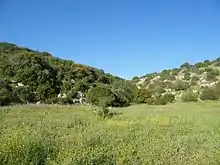
Judea is a mountainous region, part of which is considered a desert. It varies greatly in height, rising to an altitude of 1,020 m (3,346 ft) in the south at Mount Hebron, 30 km (19 mi) southwest of Jerusalem, and descending to as much as 400 m (1,312 ft) below sea level in the east of the region. It also varies in rainfall, starting with about 400–500 millimetres (16–20 in) in the western hills, rising to 600 millimetres (24 in) around western Jerusalem (in central Judea), falling back to 400 millimetres (16 in) in eastern Jerusalem and dropping to around 100 millimetres (3.9 in) in the eastern parts, due to a rainshadow effect (this is the Judean desert). The climate, accordingly, moves between Mediterranean in the west and desert climate in the east, with a strip of steppe climate in the middle. Major urban areas in the region include Jerusalem, Bethlehem, Gush Etzion, Jericho and Hebron.[14]
Geographers divide Judea into several regions: the Hebron hills, the Jerusalem saddle, the Bethel hills and the Judean desert east of Jerusalem, which descends in a series of steps to the Dead Sea. The hills are distinct for their anticline structure. In ancient times the hills were forested, and the Bible records agriculture and sheep farming being practiced in the area. Animals are still grazed today, with shepherds moving them between the low ground to the hilltops as summer approaches, while the slopes are still layered with centuries-old stone terracing. The Jewish Revolt against the Romans ended in the devastation of vast areas of the Judean countryside.[15]
Mount Hazor marks the geographical boundary between Samaria to its north and Judea to its south.
Biblical patriarchs narrative
Judea is central to much of the narrative of the Torah, with the Patriarchs Abraham, Isaac and Jacob said to have been buried at Hebron in the Tomb of the Patriarchs.
History
Iron Age, Assyrian, and Babylonian period
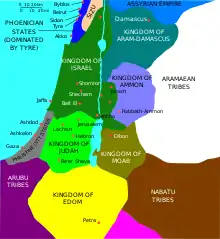
The early history of Judah is uncertain; the biblical account states that the Kingdom of Judah, along with the Kingdom of Israel, was a successor to a united monarchy of Israel and Judah, but modern scholarship generally holds that the united monarchy is ahistorical.[16][17][18][19] Regardless, the Northern Kingdom was conquered by the Neo-Assyrian Empire in 720 BCE. The Kingdom of Judah remained nominally independent, but paid tribute to the Assyrian Empire from 715 and throughout the first half of the 7th century BCE, regaining its independence as the Assyrian Empire declined after 640 BCE, but after 609 again fell under the sway of imperial rule, this time paying tribute at first to the Egyptians and after 601 BCE to the Neo-Babylonian Empire, until 586 BCE, when it was finally conquered by Babylonia.
Persian and Hellenistic periods
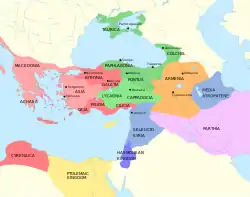
The Babylonian Empire fell to the conquests of Cyrus the Great in 539 BCE.[20] Judea remained under Persian rule until the conquest of Alexander the Great in 332 BCE, eventually falling under the rule of the Hellenistic Seleucid Empire until the revolt of Judas Maccabeus resulted in the Hasmonean dynasty of kings who ruled in Judea for over a century.[21]
Roman period
Judea lost its independence to the Romans in the 1st century BCE, becoming first a tributary kingdom, then a province, of the Roman Empire. The Romans had allied themselves to the Maccabees and interfered again in 63 BCE, at the end of the Third Mithridatic War, when the proconsul Pompeius Magnus ("Pompey the Great") stayed behind to make the area secure for Rome, including his siege of Jerusalem in 63 BCE. Queen Salome Alexandra had recently died, and a civil war broke out between her sons, Hyrcanus II and Aristobulus II. Pompeius restored Hyrcanus but political rule passed to the Herodian family who ruled as client kings. In 6 CE, Judea came under direct Roman rule as the southern part of the province of Iudaea, although Jews living in the province still maintained some form of independence and could judge offenders by their own laws, including capital offences, until c. 28 CE.[22] The Province of Judea, during the late Hellenistic period and early Roman period was also divided into five conclaves: Jerusalem (ירושלם), Gadara (גדרה), Amathus (עמתו), Jericho (יריחו), and Sepphoris (צפורין),[23] and during the Roman period had eleven administrative districts (toparchies): Jerusalem, Gophna, Akrabatta, Thamna, Lydda, Ammaus, Pella, Idumaea, Engaddi, Herodeion, and Jericho.[24]
Eventually, the Jewish population rose against Roman rule in 66 CE in a revolt that was unsuccessful. Jerusalem was besieged in 70 CE and much of the population was killed or enslaved.[25]
70 years later the Jewish population revolted under the leadership of Simon bar Kokhba and established the last Kingdom of Israel, which lasted three years, before the Romans managed to conquer the province for good, at a high cost in terms of manpower and expense.
After the defeat of Bar Kokhba (132–135 CE) the Roman Emperor Hadrian was determined to wipe out the identity of Israel-Judah-Judea, and renamed it Syria Palaestina. Until that time the area had been called the "province of Judea" (Roman Judea) by the Romans.[26] At the same time, he changed the name of the city of Jerusalem to Aelia Capitolina. The Romans killed many Jews and sold many more into slavery; many Jews departed into the Jewish diaspora, but there was never a complete Jewish abandonment of the area, and Jews have been an important (and sometimes persecuted) minority in Judea since that time.[27]
Byzantine period
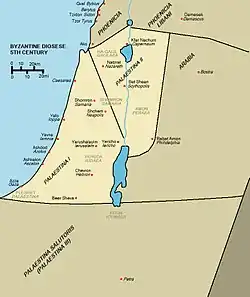
The Byzantines redrew the borders of the land of Palestine. The various Roman provinces (Syria Palaestina, Samaria, Galilee, and Peraea) were reorganized into three dioceses of Palaestina, reverting to the name first used by Greek historian Herodotus in the mid-5th century BCE: Palaestina Prima, Secunda, and Tertia or Salutaris (First, Second, and Third Palestine), part of the Diocese of the East.[28][29] Palaestina Prima consisted of Judea, Samaria, the Paralia, and Peraea with the governor residing in Caesarea. Palaestina Secunda consisted of Galilee, the lower Jezreel Valley, the regions east of Galilee, and the western part of the former Decapolis with the seat of government at Scythopolis. Palaestina Tertia included the Negev, southern Jordan—once part of Arabia—and most of Sinai, with Petra as the usual residence of the governor. Palestina Tertia was also known as Palaestina Salutaris.[28][30] According to historian H.H. Ben-Sasson,[31] this reorganisation took place under Diocletian (284–305), although other scholars suggest this change occurred later, in 390.
Timeline
- 11th century – 930 BCE: part of the united monarchy of Israel and Judah
- 930–586 BCE: Kingdom of Judah
- 586–539 BCE: Babylonian Empire
- 539–332 BCE: Persian Empire
- 332–305 BCE: Macedonian Empire of Alexander the Great
- 305–198 BCE: Ptolemaic dynasty
- 198–141 BCE: Seleucid Empire
- 141–37 BCE: The Hasmonean state established by the Maccabees, under the Roman Empire after 63 BCE
- 63 BCE: Pompey's conquest of Jerusalem
- 37 BCE – 132 CE: Herodian dynasty ruling Judea as a vassal state of the Roman Empire (37–4 BCE Herod the Great, 4 BCE – 6 CE Herod Archelaus, 41–44 CE Agrippa I), interchanging with direct Roman rule (6–41, 44–132)
- c. 25 BCE: Caesarea Maritima is built by Herod the Great
- 6 CE the Roman Empire deposed Herod Archelaus and converted his territory into the Roman province of Judea.
- Census of Quirinius, too late to correspond to census related to Jesus' birth
- 26–36: Pontius Pilate prefect of Roman Judea during the Crucifixion of Jesus
- 66–73: First Jewish–Roman War, includes Destruction of the Second Temple in 70
- 115–117: Kitos War
- 132–135: Bar Kokhba's revolt
- 135: Emperor Hadrian reverts the name to Syria Palaestina, first attested by Herodotus
Selected towns and cities
Judea, in the generic sense, also incorporates places in Galilee and in Samaria.
| English | Hebrew (Masoretic, 7th–10th century CE) | Greek (Josephus, LXX, 3rd century BCE – 1st century CE) | Latin | Arabic |
|---|---|---|---|---|
| Jerusalem | ירושלם | Ιερουσαλήμ | Herusalem (Aelia Capitolina) | القدس (al-Quds) |
| Jericho | יריחו | Ίεριχω | Hiericho / Herichonte | أريحا (Ariḥa) |
| Shechem | שכם | Νεάπολις (Neapolis) |
Neapoli | نابلس (Nablus) |
| Jaffa | יפו | Ἰόππῃ | Ioppe | يَافَا (Yaffa) |
| Ascalon | אשקלון | Ἀσκάλων (Askálōn) | Ascalone | عَسْقَلَان (Asqalān) |
| Beit Shean | בית שאן | Σκυθόπολις (Scythopolis) Βαιθσάν (Beithsan) |
Scytopoli | بيسان (Beisan) |
| Beth Gubrin (Maresha?) | בית גוברין | Ἐλευθερόπολις (Eleutheropolis) |
Betogabri | بيت جبرين (Bayt Jibrin) |
| Kefar Othnai | (לגיון) כפר עותנאי | xxx | Caporcotani (Legio) | اللجّون (al-Lajjûn) |
| Peki'in | פקיעין | Βακὰ[32] | xxx | البقيعة (al-Buqei'a) |
| Jamnia | יבנה | Ιαμνεία | Iamnia | يبنى (Yibna) |
| Samaria / Sebaste | שומרון / סבסטי | Σαμάρεια / Σεβαστή | Sebaste | سبسطية (Sabastiyah) |
| Paneas (Caesarea Philippi) | פנייס | Πάνειον (Καισαρεία Φιλίππεια) (Paneion) |
Cesareapaneas | بانياس (Banias) |
| Acre (Ptolemais) | עכו | Πτολεμαΐς (Ptolemais) Ἀκχώ (Akchó) |
Ptoloma | عكّا (ʻAkka) |
| Emmaus | אמאוס | Ἀμμαοῦς (Νικορολις) (Nicopolis) |
Nicopoli | عمواس ('Imwas) |
See also
- Timeline of the name "Judea"
- Seleucid Empire vs. Maccabean Revolt
- History of Palestine
- Ioudaios
- Kitos War
- Judaea (Roman province)
- State of Judea
References
- "Definition of Judaea in English". Lexico Dictionaries. Archived from the original on July 20, 2021. Retrieved 20 July 2021.
- Crotty, Robert Brian (2017). The Christian Survivor: How Roman Christianity Defeated Its Early Competitors. Springer. p. 25 f.n. 4. ISBN 9789811032141. Retrieved 28 September 2020.
The Babylonians translated the Hebrew name [Judah] into Aramaic as Yehud Medinata ('the province of Judah') or simply 'Yehud' and made it a new Babylonian province. This was inherited by the Persians. Under the Greeks, Yehud was translated as Judaea and this was taken over by the Romans. After the Jewish rebellion of 135 CE, the Romans renamed the area Syria Palaestina or simply Palestine. The area described by these land titles differed to some extent in the different periods.
- Neil Caplan (19 September 2011). The Israel-Palestine Conflict: Contested Histories. John Wiley & Sons. p. 8. ISBN 978-1405175395.
- Riggs, J. S. (1894). "Studies in Palestinian Geography. II. Judea". The Biblical World. 4 (2): 87–93. doi:10.1086/471491. JSTOR 3135423. S2CID 144961794 – via JSTOR.
- "A few of the careful, however, having obtained private records of their own, either by remembering the names or by getting them in some other way from the registers, pride themselves on preserving the memory of their noble extraction. Among these are those already mentioned, called Desposyni, on account of their connection with the family of the Saviour. Coming from Nazara and Cochaba, villages of Judea, into other parts of the world, they drew the aforesaid genealogy from memory and from the book of daily records as faithfully as possible." (Eusebius Pamphili, Church History, Book I, Chapter VII,§ 14)
- For example at Luke 23:5 and John 7:1
- "A/RES/181(II) of 29 November 1947". Unispal.un.org. Retrieved 2018-09-20.
- "Mandate for Palestine – Report of the Mandatory to the LoN (31 December 1937)". Unispal.un.org. Retrieved 2018-09-20.
- "This Side of the River Jordan; On Language," Philologos, September 22, 2010, Forward.
- "Judaea". Britannica. Retrieved 2012-12-31.
- Based on Charles William Wilson's (1836–1905) identification of this site, who thought that Borceos may have been a place about 18 kilometers to the south of Neapolis (Nablus) because of a name similarity (Berkit). See p. 232 in: Wilson, Charles William (1881). Picturesque Palestine, Sinai and Egypt. Vol. 1. New York: D. Appleton.. This identification is the result of the equivocal nature of Josephus' statement, where he mentions both "Samaria" and "Judea." Samaria was a sub-district of Judea. Others speculate that Borceos may have referred to the village Burqin, in northern Samaria, and which village marked the bounds of Judea to its north.
- "Ancient History Sourcebook: Josephus (37 – after 93 CE): Galilee, Samaria, and Judea in the First Century CE". Fordham.edu. Retrieved 2012-12-31.
- Josephus, Antiquities XIV.I.4. (14.14)
- "Picturesque Palestine I: Jerusalem, Judah, Ephraim". Lifeintheholyland.com. Retrieved 2012-12-31.
- "Unlikely A Tale of Two Conquests: The Unlikely Numismatic Association Between the Fall of New France (AD 1760) and the Fall of Judaea (AD 70)". Ansmagazine.com. Archived from the original on 2012-07-07. Retrieved 2012-12-31.
- Kuhrt, Amiele (1995). The Ancient Near East. Routledge. p. 438. ISBN 978-0415167628.
- Finkelstein, Israel, and Silberman, Neil Asher, The Bible Unearthed : Archaeology's New Vision of Ancient Israel and the Origin of Its Sacred Texts, Simon & Schuster, 2002. ISBN 0-684-86912-8
- "The Bible and Interpretation – David, King of Judah (Not Israel)". bibleinterp.arizona.edu. 2014-07-13. Retrieved 2018-09-20.
- Thompson, Thomas L., 1999, The Bible in History: How Writers Create a Past, Jonathan Cape, London, ISBN 978-0-224-03977-2 p. 207
- "Cyrus the Great | Biography & Facts | Britannica". www.britannica.com. Retrieved 2022-06-26.
- "Palestine - The Hasmonean priest-princes | Britannica". www.britannica.com. Retrieved 2022-06-26.
- Babylonian Talmud, Avodah Zarah 8b; ibid, Sanhedrin 41a
- Josephus, Antiquities Book 14, chapter 5, verse 4
- Schürer, E. (1891). Geschichte des jüdischen Volkes im Zeitalter Jesu Christi [A History of the Jewish People in the Time of Jesus Christ]. Geschichte de jüdischen Volkes im Zeitalter Jesu Christi.English. Vol. 1. Translated by Miss Taylor. New York: Charles Scribner's Sons. p. 157. Cf. Flavius Josephus, The Wars of the Jews 3:51.
- "Titus' Siege of Jerusalem – Livius". www.livius.org.
- H.H. Ben-Sasson, A History of the Jewish People, Harvard University Press, 1976, ISBN 0-674-39731-2, page 334: "In an effort to wipe out all memory of the bond between the Jews and the land, Hadrian changed the name of the province from Iudaea to Syria-Palestina, a name that became common in non-Jewish literature."
- David Goodblatt, 'The political and social history of the Jewish community in the Land of Israel,' in William David Davies, Louis Finkelstein, Steven T. Katz (eds.) The Cambridge History of Judaism: Volume 4, The Late Roman-Rabbinic Period, Cambridge University Press, 2006 pp.404-430, p.406.
- Shahin (2005), p. 8
- Thomas A. Idniopulos (1998). "Weathered by Miracles: A History of Palestine From Bonaparte and Muhammad Ali to Ben-Gurion and the Mufti". The New York Times. Retrieved 2007-08-11.
- "Roman Arabia". Encyclopædia Britannica. Archived from the original on 2007-10-11. Retrieved 2007-08-11.
- H.H. Ben-Sasson, A History of the Jewish People, Harvard University Press, 1976, ISBN 0-674-39731-2, p. 351
- Josephus, The Jewish War 3.3.1
External links
- Judea and civil war
- The subjugation of Judea
- Judaea 6–66 CE Archived 2015-05-03 at the Wayback Machine
- Judea photos
- The Jewish History Resource Center—Project of the Dinur Center for Research in Jewish History, Hebrew University of Jerusalem